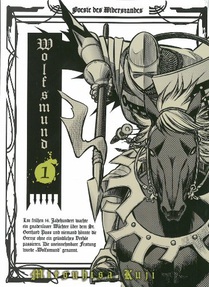Review
by Rebecca Silverman,Wolfsmund
GN 1
| Synopsis: |  |
||
In the 14th century the Austrian Empire laid claim to three Swiss cantons (districts) and began to keep a strict watch over the Sankt Gotthard Pass in order to maintain control over the Swiss people. That particular pass is the most direct route into Italy and in charge of it is the cruelest man of all – a vicious creature named Wolfram. Wolfram takes great pleasure in thwarting those who would flee the oppressors, killing without mercy whether it is warranted or not. How long will the people stand for this treatment? Is there any hope for the rebels at all? |
|||
| Review: | |||
The Alps, fourteenth century. Three small, formerly autonomous Swiss cantons have fallen under the power of the Austrian Empire, and the new rulers seek to oppress the native people. One of the ways they've chosen to do this is to severely restrict travel into and out of the cantons. The main route, to say nothing of the easiest, is to go through Sankt Gotthard Pass, which links the country to Italy. Egress is only permitted if the traveler has a governmentally issued pass, and those are rarely, if ever, given to the everyday locals. This doesn't stop people from attempting to flee through the pass. Unfortunately for them, the bailiff for the Pass is a horrible, sadistic man named Wolfram, and his unmitigated cruelty has earned the Pass the nickname of “The Wolf's Maw.” Wolfsmund is a book that pulls no punches, and it's a little surprising that it is only rated T+ (or the Vertical equivalent). Heads roll, blood flies, pubic hair is exposed, and brutality reigns supreme. A large part of the horror comes not from the violent acts themselves, but from the callous manner in which they are carried out. The first story, “Liese and Georg,” is by far the most visceral. It begins with a man's beheading, and Kuji is very careful to show us that there were two headmen at the time – one to get the axe in place and another to throw down a hammer blow to sever the head. Once the man is dead, the authorities begin looking for his daughter, who has escaped with a knight. Liese and Georg plan to fool the bailiff of Sankt Gotthard Pass by disguising Liese as a boy, and thereby win their freedom. The bailiff, however, lives up to his reputation. The swift conclusion to the tale is shocking in its brutality and a good example of effective storytelling. The effort to incorporate historical detail into Wolfsmund is readily apparent, and the inclusion of Swiss rebel folk hero William Tell into the third story in the book helps with this. Tell's legendary apple feat is included as backstory, and the way Kuji presents him makes the act seem heroic and plausible, at least within the bounds of seinen manga. The second story in the book is the least historical, as it features a woman who appears to be some sort of 14th century Swiss ninja. (Not that there were not impressive hand-to-hand combat arts in medieval Europe, but the way Johanna fights looks very ninja-esque.) The art mostly reflects this devotion to historical accuracy, with the backgrounds being the most impressive. A quick Internet search for the pass shows it to be instantly recognizable from Kuji's drawings, and weaponry looks to be mostly accurate as well. Clothing isn't quite as well done, although it is worth mentioning that Kuji is aware that underwear was not worn at the time, with the unnamed female innkeeper of Sankt Gotthard having the most suspicious outfit. The sourest note, however, is simply the occasionally too-sparkly eyes. Yes, this is an odd thing to complain about in a manga, however, the rest of Kuji's style is so gritty or realistic that obvious manga trappings such as the odd character with shoujo eyes stand out and disrupt the visual flow. Liese and Walter suffer from this the most, as does the Innkeeper. Despite her appearance, the Innkeeper is one of the most interesting characters in the book. One of only several recurring players, she is more complex than the others, especially the villain, Wolfram, who pretty much feels like a one-note bad guy. He enjoys tormenting others and causing pain, and he smiles beatifically while he does so – yes, he's scary, but he's also pretty standard fare. The Innkeeper is clearly a rebel and invested in the rebel cause, but she's also wise enough to keep herself under the radar. She knows a wide variety of people and isn't above using her body to help her get what she wants or to promote the cause – but she's not painted in a bad light for it. It would not be surprising to see the eventual outcome of the story hinge upon her actions, and with her being present for every story, she is easy to keep an eye on. Overall Wolfsmund is brutal, and that is largely a product of the mangaka's excellent presentation of his material. From artistic blood that occasionally looks like jewels to swift scenes of violence or a bit of fanservice more in the interest of plot than prurience, Wolfsmund pulls few punches and hits you in the gut. Fans of historical fiction that pays attention to the history or those looking for some well done seinen should check this one out...but maybe don't read it just before bed or dinner. |
| Grade: | |||
|
Overall : B
Story : B
Art : B
+ Attention to detail in art and history, Innkeeper has potential as a character. Some interesting artistic choices that work. |
|||
| discuss this in the forum (3 posts) | | |||
| Production Info: | ||
|
Full encyclopedia details about Release information about |
||